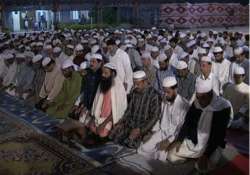Flashback: How 800 Dalit Hindus in Meenakshipuram were converted to Islam 33 years ago
New Delhi: On February 19, 1981, when the late M G Ramachandran was the chief minister of Tamil Nadu, the nation woke up to a news item which said nearly 800 Dalit Hindus in the

New Delhi: On February 19, 1981, when the late M G Ramachandran was the chief minister of Tamil Nadu, the nation woke up to a news item which said nearly 800 Dalit Hindus in the tiny hamlet of Meenakshipuram in Tirunelveli district had converted to Islam. Meenakshipuram is now also known as Rahmat Nagar.
There were nearly 300 Dalit Hindu families who embraced Islam, tired of upper caste atrocities, mostly by the landed OBC Thevar community in the village.
The then BJP leader Atal Bihari Vajpayee was among a large number of leaders who travelled to this hamlet to find out why the Dalit Hindus had converted to Islam.
After uproar in media and Parliament by the BJP and Hindu organisations, the Justice Venugopal Inquiry Commission was set up to probe the Meenakshipuram conversions.
In 1986, the Commission recommended a law to ban forcible conversions. The then CM M G Ramachandran agreed, but he shelved the report.
Sixteen years later, Jayalalithaa's government in 2002 came up with the Tamil Nadu Prohibition of Forcible Conversion of Religion Act.
At that time, the then Union Minister M Venkaiah Naidu had advocated that other state governments should also formulate similar laws. That was 12 years ago, and Naidu was harping on the same thing on Thursday in Parliament.
The Official Report of the Director of SC/ST, Government of India on the Meenakshipuram Conversions said: "The converted Harijans categorically said that it was they who approached the Muslims first...
They went to Tirunelveli and approached the Muslim leaders to allow them to join Islam; their elders have been thinking of converting to Islam for the past 20 years. The converts contributed Rs 41,000 for their conversion ceremony."
The mass conversions did not significantly change the economic conditions of the Dalits in Meenakshipuram, but rid them of social insults that they were suffering at the hands of upper castes.
Some converts got jobs in the Gulf, but most of the landless labourers remained the same. Yet, none of them returned to the fold of Hinduism, because they were tired of being discriminated by upper castes.
The Arya Samaj set up a mandapam and a school building in the hamlet in 1981 soon after the mass conversions, in order to re-convert the Dalits, but these buildings now remain abandoned and dilapidated. There was no re-conversion in reality.
Most of the converted Dalits in Meenakshipuram have become staunch supporters of AIADMK, while the Thevars have aligned with the BJP. Hindus do not enter the mosque in the hamlet, while Muslims do not enter the temple.
The 1981 mass conversion was then carried out by the Ishaadul Islam Sabha of South India.
This outfit later tried to convert more Dalit Hindus in Ramnathapuram and Madurai districts, but the nationwide furore among Hindu outfits like the Vishwa Hindu Parishad, Hindu Munnani, RSS, Arya Samaj, Hindu Samudaya Valarchi Manram and Hindu Ottrumai Maiyam (Centre for Hindu Unity) forced the Muslim outfit to tone down its campaign.
